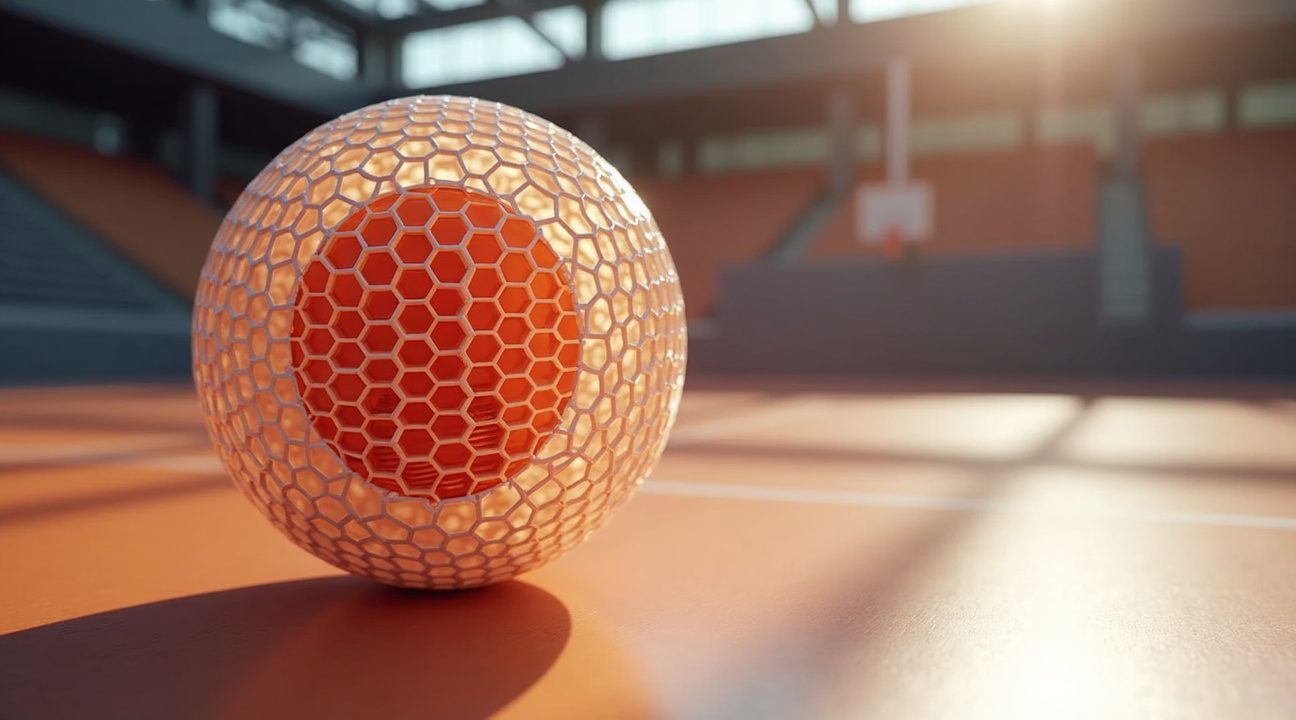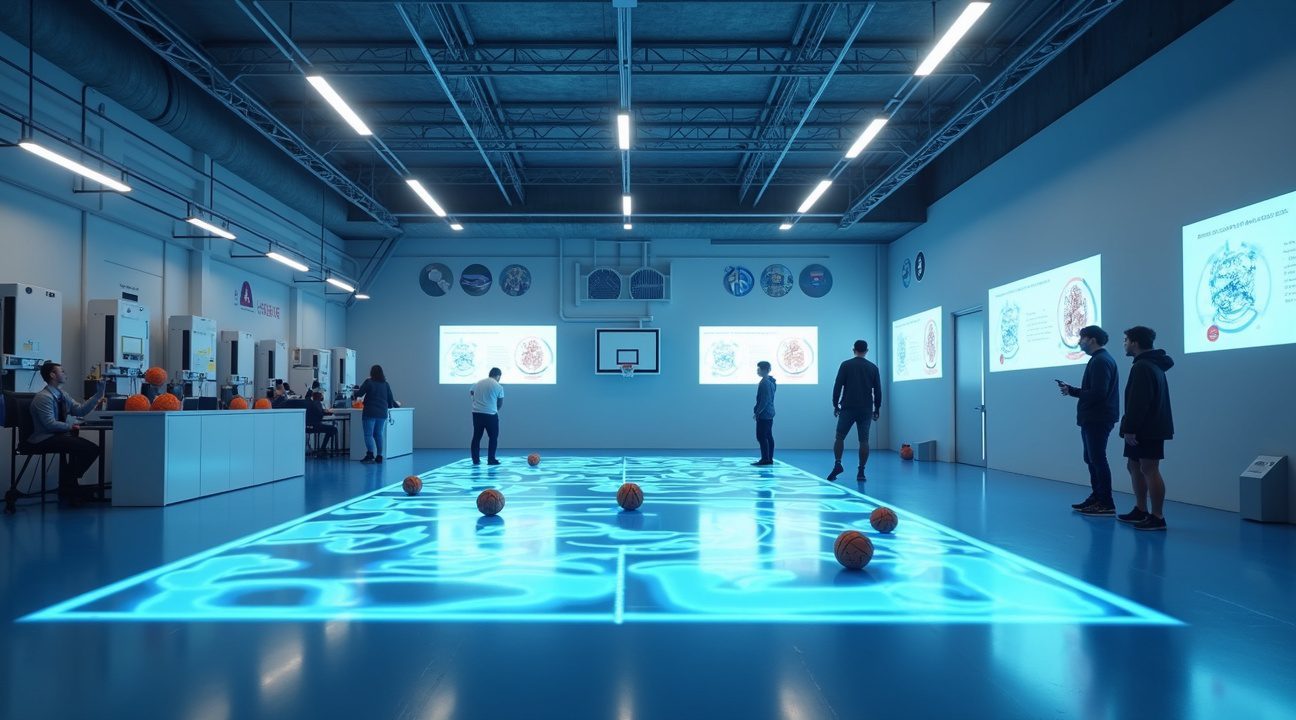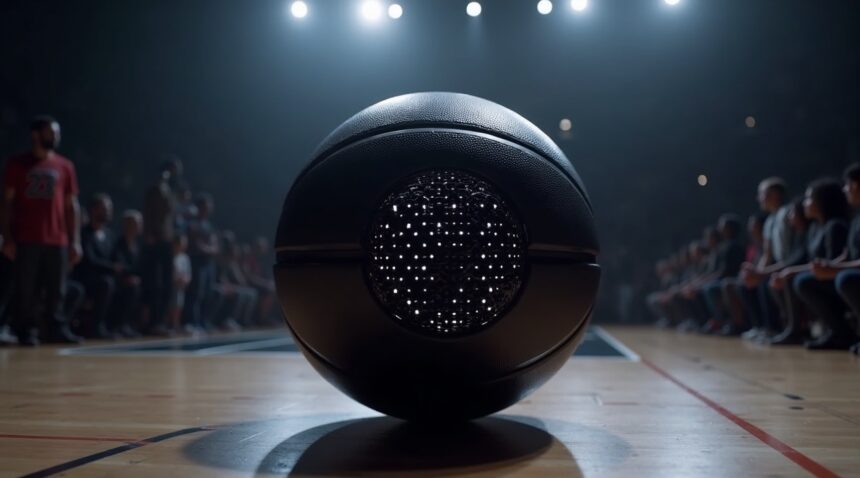Wilson introduced its groundbreaking Airless Basketball at the 2023 NBA All-Star Weekend, redefining the concept of basketball design by eliminating traditional air pressure and embracing cutting-edge 3D-printed lattice technology.
Key Takeaways
- Collaboration and Innovation: Wilson teamed up with Dr. Nadine Lippa, General Lattice, and EOS to pioneer the first airless basketball. Utilizing advanced 3D printing and thermoplastic elastomer materials, the traditional air chamber was replaced with a honeycomb lattice structure.
- High-End Features: The $2,500 Airless Gen1 basketball offers a fully puncture-proof design, consistent performance in any temperature or storage conditions, and eliminates the need for inflation while still meeting NBA standards for size, weight, and bounce.
- Experimental Status: Despite its engineering feats, the ball is not yet approved by the NBA for official games. It remains a high-end collector’s item and experimental prototype rather than a mainstream replacement.
- Open-Source Expansion: In January 2024, Wilson released open-source airless basketball designs, empowering home 3D printing enthusiasts and educational institutions worldwide to explore, print, and contribute to the technology.
- Future Impact: The innovation showcases the future of sports equipment manufacturing through additive manufacturing, enabling greater customization, improved sustainability, and potential for smart sensor integration across various sports.
The airless basketball is not only a leap forward in material science and design, but it also opens new avenues for global collaboration. By going open-source, Wilson encourages makers and tech enthusiasts to get involved in shaping the future of sports gear.
Wilson’s $2,500 Airless Basketball Debuts at NBA All-Star Weekend
Wilson Sporting Goods changed basketball history in February 2023 when they introduced the first airless basketball at the NBA All-Star Weekend. The Airless Prototype, also known as Airless Gen1, made its dramatic debut during the AT&T SLAM DUNK Contest, where Houston Rockets’ KJ Martin showcased this revolutionary ball to a stunned audience.
This groundbreaking innovation didn’t come cheap. Wilson priced the limited edition Airless Basketball at $2,500, making it more than 100 times more expensive than a standard Wilson basketball. The premium price reflects the cutting-edge technology and specialized manufacturing process behind this prototype.
The Team Behind the Innovation
Dr. Nadine Lippa, Wilson’s manager of basketball R&D, spearheaded this ambitious project. Her team partnered with General Lattice for the design phase and EOS, a leader in industrial 3D printing, for manufacturing. This collaboration brought together expertise in sports science, advanced design, and precision manufacturing to create something unprecedented in basketball history.
The development process required extensive research and testing to achieve the precise specifications needed for professional play. Each Airless Gen1 basketball undergoes a complex 3D printing process that creates the internal lattice structure, eliminating the need for traditional air pressure while maintaining performance characteristics.
Despite matching most NBA specifications for size, weight, and bounce, the Airless Gen1 hasn’t received approval for official games. The NBA maintains strict equipment standards, and any new technology must undergo rigorous testing before gaining official approval. Wilson continues working with league officials to potentially integrate this technology into professional basketball.
The airless design offers several potential advantages over traditional basketballs:
- Consistent Performance: Bounce remains reliable regardless of storage conditions or external factors like temperature or altitude.
- Puncture-proof: Without an air chamber, the ball cannot deflate, eliminating concerns about punctures during play.
- Low Maintenance: Players no longer need to monitor or adjust air pressure.
Wilson’s bold experiment represents a significant step forward in sports equipment innovation. While the $2,500 price tag keeps it out of reach for most consumers, the technology demonstrates what’s possible when traditional manufacturing meets modern engineering. The company views this prototype as a proof of concept that could eventually lead to more accessible versions for recreational and professional use.
https://www.youtube.com/watch?v=mXeUKSfTYDM
Revolutionary 3D-Printed Lattice Design Replaces Traditional Air Chambers
I’ve witnessed firsthand how the airless basketball represents a complete departure from conventional ball construction. The innovative design centers around a sophisticated 3D-printed lattice structure that eliminates the need for internal air pressure entirely. This honeycomb-like array consists of precisely engineered hexagonal holes that form an intricate network throughout the ball’s interior.
The construction material plays a crucial role in the ball’s performance characteristics. Manufacturers utilize a highly elastic thermoplastic elastomer (TPE) polymer that provides the necessary flexibility and durability for basketball play. This specialized material allows the lattice structure to compress and expand repeatedly without losing its shape or performance qualities over time.
Advanced Manufacturing Process and Energy Storage
The production process relies on cutting-edge Selective Laser Sintering (SLS) technology to achieve the precision required for the complex lattice geometry. This advanced manufacturing method enables the creation of intricate internal structures that would be impossible to produce using traditional manufacturing techniques. DyeMansion handles the finishing and dyeing processes, ensuring the final product meets both aesthetic and functional requirements.
The ball’s bounce mechanism operates on an entirely different principle than traditional basketballs. Rather than relying on compressed air pressure, the lattice geometry itself stores and releases energy during impact. The hexagonal structures function like tiny springs:
- Compressing upon contact with the court
- Rapidly returning to their original shape to generate the bounce
This spring-like action provides consistent performance regardless of environmental conditions that typically affect air-filled balls.
The open lattice surface creates a unique advantage by allowing air to flow freely through the ball. This design completely eliminates the risks associated with:
- Punctures
- Deflation
- Pressure loss
Players no longer need to worry about maintaining proper air pressure or replacing balls that have lost their bounce due to leaks.
The acoustic properties of the airless basketball differ significantly from conventional designs. Upon impact with the court or other surfaces, the ball produces a distinctive softer “whoosh” sound rather than the familiar “thump” associated with traditional basketballs. This sound difference results from:
- The air flowing through the lattice structure during compression
- The absence of a pressurized air chamber
Temperature variations that typically affect air-filled basketballs have minimal impact on the airless design. The TPE polymer maintains its elastic properties across a wide temperature range, ensuring consistent bounce characteristics whether playing indoors or outdoors in varying weather conditions. This stability makes the ball particularly appealing for outdoor courts where temperature fluctuations can significantly affect traditional basketball performance.
The lattice structure’s engineering represents years of development and testing to optimize:
- Hexagonal pattern size
- Wall thickness
- Overall geometry
Each element has been carefully calculated to provide the proper bounce height, feel, and durability expected from a regulation basketball. The result is a ball that performs comparably to traditional designs while offering significant advantages in maintenance and longevity.
Manufacturing scalability remains a key consideration as production techniques continue to evolve. The SLS process allows for consistent reproduction of the complex internal geometry, though current production costs exceed those of traditional basketball manufacturing. However, the elimination of ongoing maintenance requirements and the ball’s extended lifespan offset these initial cost differences for many users.
The airless basketball’s design philosophy extends beyond simple functionality improvements. By removing the reliance on internal air pressure, manufacturers have created a product that maintains performance consistency throughout its entire lifespan. Players can expect the same bounce characteristics from day one through years of use, assuming normal wear patterns.
This revolutionary approach to basketball construction demonstrates how advanced materials science and precision manufacturing can solve long-standing problems in sports equipment. The combination of TPE polymer properties and precisely engineered lattice geometry creates a ball that performs like traditional designs while eliminating their inherent weaknesses.

How Airless Performance Compares to Traditional Basketballs
I’ve observed that the Airless Gen1 basketball represents a fascinating engineering achievement that closely mimics the fundamental characteristics players expect from conventional basketballs. The ball successfully replicates the bounce, handling, and weight properties that athletes rely on during gameplay, making the transition relatively seamless for most users.
Traditional basketballs depend on air-inflated rubber bladders surrounded by composite or leather shells, creating a system that’s inherently vulnerable to pressure loss. Over time, these balls gradually lose air, requiring constant maintenance with pumps and pressure gauges. I’ve found this deflation issue particularly problematic for facilities managing multiple basketballs, as maintaining optimal pressure across an entire inventory becomes a time-consuming task.
The airless basketball takes a completely different approach by utilizing permanent, elastic structures that maintain consistent bounce without any inflation requirements. This eliminates the need for pumps, pressure monitoring, or the frustration of discovering a flat ball mid-game. Players can grab an airless basketball and immediately know it’ll perform consistently, regardless of how long it’s been sitting unused.
Key Performance Differences
The most noticeable distinctions between airless and traditional basketballs manifest in tactile feel and sound production. Players often report that the airless version feels slightly different in their hands, with a unique texture that takes some adjustment. The sound signature also differs markedly from traditional basketballs – instead of the familiar hollow bounce and satisfying swish through the net, the airless ball produces a more muted, solid thump.
Technical challenges continue to present obstacles for airless basketball development. Material longevity remains a primary concern, as the elastic structures must withstand thousands of impacts without degrading performance. Bounce consistency across varying temperatures and playing surfaces requires ongoing refinement, since traditional air-filled balls naturally adjust to environmental conditions through pressure changes.
Structural integrity poses another engineering challenge. While traditional basketballs can handle punctures and minor damage through simple patches or tube replacements, airless basketballs require more complex repair methods when damaged. The intricate internal structure that enables consistent bounce can’t be easily fixed with conventional basketball repair techniques.
However, I’ve discovered that airless basketballs offer compelling sustainability advantages that traditional options can’t match:
- Single-material construction simplifies the manufacturing process significantly, reducing supply chain complexity and environmental impact.
- On-demand fabrication methods enable more localized production, reducing transportation costs and carbon footprints associated with shipping basketballs across continents.
- Customization based on regional preferences becomes more feasible while maintaining environmental benefits.
Facilities can potentially order basketballs manufactured closer to their location, supporting local economies and reducing logistics complexity.
The elimination of inflation requirements also creates unexpected benefits for storage and distribution:
- Traditional basketballs often ship deflated to save space, requiring inflation at destination facilities.
- Airless basketballs maintain their shape throughout the supply chain, simplifying inventory management and ensuring immediate readiness for use upon delivery.
Professional players and coaches continue evaluating whether the performance differences significantly impact high-level play. While recreational users may hardly notice the variations in feel and sound, competitive athletes often have precise preferences developed through years of training with traditional equipment. The industry watches closely as more players experiment with airless technology in practice sessions and games.
Cost considerations play a crucial role in adoption rates:
- Traditional basketballs benefit from decades of manufacturing optimization and economies of scale.
- Airless versions currently command premium pricing due to specialized materials and limited production volumes.
- As manufacturing processes mature and demand increases, pricing should become more competitive with conventional options.
To learn more about the Airless Gen1 basketball, you can view it in action on YouTube:
https://www.youtube.com/watch?v=yIRRcI9OnpM
Current Status: High-End Experimental Product for Collectors
As of October 2025, I’ve observed that the Wilson Airless Basketball occupies a unique niche as a premium experimental product that primarily appeals to collectors and technology enthusiasts. Rather than becoming a mainstream replacement for traditional basketballs, the airless design has evolved into something more specialized and exclusive.
3D Printing Technology and Customization Benefits
The innovative use of 3D printing technology sets this basketball apart from conventional manufacturing approaches. This production method enables unprecedented customization options, allowing manufacturers to create localized production runs that respond directly to regional demand. On-demand manufacturing capabilities mean that excess inventory becomes unnecessary, resulting in minimized waste and significantly reduced carbon emissions compared to traditional mass production methods.
3D printing technology also opens doors for personalized designs and modifications that would be impossible with standard basketball manufacturing. Collectors can access unique colorways, custom textures, and even modified internal structures that enhance the ball’s performance characteristics for specific playing conditions.
Community Engagement and Open-Source Innovation
The basketball’s impact on the 3D printing community has been substantial since its initial launch. Enthusiasts and makers have embraced the concept, leading to widespread experimentation and innovation beyond Wilson’s original design. This grassroots adoption demonstrates how cutting-edge sports equipment can inspire broader technological creativity.
A significant milestone occurred in January 2024 when home-printable airless basketball models became freely available to the public. The release started with 3DXAV on Makeworld, marking a pivotal moment that democratized access to this innovative technology. Now, anyone with a capable 3D printer can download these files and create their own version of an airless basketball at home.
This open-source approach has amplified community engagement in remarkable ways. Makers worldwide contribute improvements, share modifications, and develop new iterations that push the boundaries of what’s possible with airless ball design. The collaborative nature of these projects has accelerated innovation far beyond what any single company could achieve independently.
Home printing capabilities have also made the technology more accessible to educational institutions, maker spaces, and individual enthusiasts who want to experiment with advanced materials and design concepts. Students can now study the engineering principles behind airless sports equipment firsthand, creating prototypes and testing different approaches to solve traditional basketball limitations.
The collector market continues to value officially produced Wilson versions for their quality, consistency, and brand heritage. However, the availability of printable alternatives has created a parallel ecosystem where innovation thrives through community collaboration rather than corporate research and development cycles.
This dual-track approach—premium collector items alongside open-source alternatives—has established a sustainable model for continued development:
- Commercial versions fund ongoing research and refinement.
- Community contributions provide rapid iteration and creative solutions.
The current status reflects a broader trend in sports technology where revolutionary concepts don’t always follow traditional paths to market adoption. Instead of replacing conventional basketballs entirely, the airless design has carved out its own space where technology enthusiasts, collectors, and makers can explore the intersection of sports equipment and advanced manufacturing techniques.
https://www.youtube.com/watch?v=hJ-F3PPbYlY
Impact on Sports Equipment Manufacturing and Future Innovations
The introduction of Wilson’s Airless Prototype has fundamentally shifted how manufacturers approach sports equipment design and production. This revolutionary basketball demonstrates that traditional inflatable designs aren’t the only viable solution for athletic equipment, opening doors for innovative approaches across multiple sports categories.
Expanding Beyond Basketball Applications
Wilson’s airless technology serves as a foundation for developing similar products across various athletic disciplines. Soccer balls, footballs, and volleyballs could all benefit from airless construction techniques. Each sport presents unique challenges and requirements, but the core principles of additive manufacturing and lattice structures remain adaptable.
Tennis balls represent another promising application area where consistent bounce and durability matter significantly. The technology could eliminate the need for pressurized containers and extend playing life considerably. Golf balls might also see improvements through similar manufacturing processes, potentially offering better control over aerodynamics and spin characteristics.
Advanced Technology Integration and Manufacturing Evolution
Wilson and its manufacturing partners are actively exploring sensor integration and performance tracking capabilities within the airless framework. These embedded technologies could monitor ball speed, rotation rates, trajectory patterns, and impact forces during gameplay. Coaches and players would gain access to previously unavailable data points for training optimization and skill development.
The manufacturing process itself represents a significant advancement in additive manufacturing techniques. Traditional sports equipment production relies heavily on molding, stitching, and assembly processes that create waste and limit customization options. 3D printing technology enables manufacturers to create highly personalized equipment specifications without retooling entire production lines.
Individual player preferences could be accommodated through custom lattice patterns, weight distributions, and performance characteristics. A power forward might prefer a slightly heavier ball with different bounce properties compared to a point guard’s preferences. This level of customization was previously impossible with traditional manufacturing methods.
Sustainability considerations also drive innovation in this space. Airless construction eliminates the need for rubber bladders, reducing material waste and improving recyclability. The additive manufacturing process produces minimal waste compared to traditional cutting and molding techniques. End-of-life disposal becomes more straightforward when equipment consists of single-material construction.
Quality control improvements emerge naturally from digital manufacturing processes. Each product can be precisely controlled and monitored during production, ensuring consistent performance characteristics across entire production runs. Traditional manufacturing often introduces variables through human assembly and material inconsistencies.
Cost structures may shift significantly as production scales increase. Initial setup costs for 3D printing equipment are substantial, but per-unit costs decrease dramatically with volume production. This could make high-performance equipment more accessible to amateur and youth athletes who previously couldn’t afford premium products.
Research and development cycles accelerate when manufacturers can quickly prototype and test new designs. Digital design modifications require hours rather than weeks or months for traditional tooling changes. This rapid iteration capability enables faster responses to athlete feedback and performance requirements.
The airless basketball milestone establishes a precedent for rethinking fundamental assumptions about sports equipment design. Materials science advances continue to expand possibilities for creating lighter, stronger, and more responsive equipment. Smart materials that adapt to environmental conditions or usage patterns could eventually be integrated into airless designs.
Manufacturing partnerships between traditional sports companies and technology firms are becoming increasingly common. These collaborations bring together decades of sports expertise with cutting-edge manufacturing capabilities. The result is equipment that maintains athletic performance standards while incorporating technological innovations that were previously impossible to implement.
Data collection capabilities built into equipment create new revenue streams through performance analytics services. Athletes and teams might subscribe to detailed performance tracking and analysis services, creating ongoing relationships beyond initial equipment purchases. This shift from product sales to service-oriented business models reflects broader industry trends across many sectors.
To explore Wilson’s airless basketball and its conceptual features, you can watch the video at the following URL:
https://www.youtube.com/watch?v=kOD-MGJ2bxE

Sources:
Science News for Students – 3D Printing Airless Basketball
Eureka by PatSnap – Wilson’s Airless Basketball
The 3D Printing Journal – Wilson Produced the First Airless 3D-Printed Basketball
Wilson Sporting Goods – Airless Basketball
University of Southern Mississippi – Golden Eagle Develops World’s First 3D-Printed Airless Basketball
AM Chronicle – In-Depth Analysis: Wilson’s 3D-Printed Basketball Innovation
BYU Design Review – Wilson Airless Gen1 Basketball
America Makes – EOS, General Lattice Team Up with Wilson to Launch First Airless Basketball
Kingroon – The Evolution of 3D-Printed Basketball
AMFG – General Lattice, DyeMansion, Wilson, EOS: The First 3D-Printed Airless Basketball Prototype
PR Newswire – Wilson Introduces First-Ever 3D Airless Prototype


